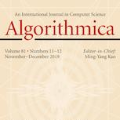The Subset Feedback Vertex Set problem (SFVS), to delete $k$ vertices from a given graph such that any vertex in a vertex subset (called a terminal set) is not in a cycle in the remaining graph, generalizes the famous Feedback Vertex Set problem and Multiway Cut problem. SFVS remains $\mathrm{NP}$-hard even in split and chordal graphs, and SFVS in Chordal Graphs (SFVS-C) can be considered as a special case of the 3-Hitting Set problem. However, it is not easy to solve SFVS-C faster than 3-Hitting Set. In 2019, Philip, Rajan, Saurabh, and Tale (Algorithmica 2019) proved that SFVS-C can be solved in $2^k n^{\mathcal{O}(1)}$, slightly improving the best result $2.076^k n^{\mathcal{O}(1)}$ for 3-Hitting Set. In this paper, we break the "$2^k$-barrier" for SFVS-C by giving a $1.619^k n^{\mathcal{O}(1)}$-time algorithm. Our algorithm uses reduction and branching rules based on the Dulmage-Mendelsohn decomposition and a divide-and-conquer method.
翻译:Subset 反馈 Vertex Set 问题 (SFVS), 要从给定的图表中删除 $k$ 的顶点, 这样在顶点子子子集( 称为终端集) 中的任何顶点在剩余图表中不是周期, 概括了著名的反馈 Vertex Set 问题和多路截断问题。 SFVS 即使在分裂和相色图中仍然 $- hard 美元, 和 相色图中的 SFVS (SFVS- C) 也可以被视为三重点设置问题的一个特例 。 然而, 要快速解决 SFVS- C (称为终端集) 问题并不容易。 在2019年, Philip, Rajan, Saurabh, 和 Tale (Algorithmica 2019) 中, SFVS- C 即使在分裂和三重价计算中, 略改进最佳结果 $0.076k n ⁇ com{O} (Obal_ balting, 在提供 lishal- rual_ rual_ sal_ sal_ slage a broma_ slate rude roma_ sal_ sal_ ruce rolational_ rolationslationslations




